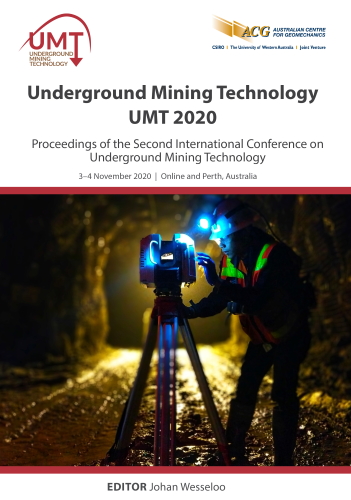Large seismic events (M > 0) in the Lappberget orebody, Garpenberg, Sweden: blast or non-blast-related?

|
Authors: Erguncu Güçlü, I; Dineva, S; Mozaffari, S; Nyström, A |
DOI https://doi.org/10.36487/ACG_repo/2035_06
Cite As:
Erguncu Güçlü, I, Dineva, S, Mozaffari, S & Nyström, A 2020, 'Large seismic events (M > 0) in the Lappberget orebody, Garpenberg, Sweden: blast or non-blast-related?', in J Wesseloo (ed.), UMT 2020: Proceedings of the Second International Conference on Underground Mining Technology, Australian Centre for Geomechanics, Perth, pp. 189-204, https://doi.org/10.36487/ACG_repo/2035_06
Abstract:
The definition of large magnitude events for mining-induced seismicity highly depends on the general pattern of seismicity in the underground mine. The seismic system in the underground Garpenberg Mine, located in Sweden, was installed in June 2012. In total, 40,000 events were recorded by the end of 2018 with the largest event of magnitude M 2.3. The large seismic events in Garpenberg Mine are defined as the events with M > 0 and very large events with M > 1. This study is based on data from the Lappberget orebody from 2012 to the end of 2018. A seismically active zone was defined in the Lappberget orebody on the northeast side with approximately 90% of the seismicity. The larger magnitude events occurred mostly in this zone too. The large events occurred at depth above 1,000 m, and the so-called very large seismic events, above 750 m. The events in the upper levels, above 700 m, are characterised by comparatively lower apparent stress than the events below. It was found that 24 % of the large seismic events were triggered by production blasts within 24 hours and 150 m. Most of the blast-related large events occurred within two hours after blasting. Only a few large seismic events had intense aftershocks. The aftershock series lasts for around 10 hours and are within 150 m of the main shock. In case of more a complicated situation with blast relation and multiple large events, the aftershock series lasts more than 60 hours. Based on the observations made here, some simple rules were defined for closing mine areas after large seismic events (so-called re-entry protocol for large seismic events). The reasonable restriction after the large seismic event would be three hours with a 150 m radius from the hypocentre of the large seismic event. The duration might be extended depending on the pattern of the aftershock sequence, especially for the large seismic events that occurred after blasting. In this case, the procedure of re-entry protocol for post-blast sequences must be followed. The obtained information about the relation between the large events and blasting can be used also for the re-entry protocol after blasting.
Keywords: mining-induced seismicity, large magnitude events, blasting, re-entry protocol
References:
Ahmadi, O, Juhlin, C, Malehmir, A & Munck, M 2013, ‘Case history high-resolution 2D seismic imaging and forward modeling of a polymetallic sulfide deposit at Garpenberg, central Sweden’, Geophysics, vol. 78 no. 6, pp. B339–350.
Allen, R, Bull S, Ripa M & Jonsson, R 2003, ‘Regional stratigraphy, basin evolution, and the setting of stratabound Zn-Pb-Cu-Ag-Au deposits in Bergslagen, Sweden’, Project 03-1203/99, Geological Survey of Sweden and Boliden Mineral AB.
Brune, JN 1970, ‘Tectonic stress and the spectra of seismic shear waves from earthquakes’, Journal of Geophysical Research, vol. 75, no. 26, pp. 4997–5009.
Eneva, M 1998, ‘In search for a relationship between induced microseismicity and larger events in mines’, Tectonophysics, vol. 289, iss. 1–3, pp. 91–104.
Erguncu Güçlü, İ 2016, Rockmass Reaction to Blasting in Mines Studied by Local Induced Seismicity, master thesis, İstanbul Technical University, İstanbul,
Friedel, MJ, Scott, DF & Williams, TJ 1997, ‘Temporal imaging of mine-induced stress change using seismic tomography’, Engineering Geology, vol. 46, no. 2, pp. 131–41.
Harris, PC & Wesseloo, J 2015, mXrap, version 5, computer software, The Australian Centre for Geomechanics, The University of Western Australia, Perth, http://www.mXrap.com
Hudyma, M & Potvin, YH 2010, ‘An engineering approach to seismic risk management in hardrock mines’, Rock Mechanics and Rock Engineering, vol. 43, pp. 891–906.
Jansson, N 2011, The Origin of Iron Ores in Bergslagen, Sweden, and Their Relationships with Polymetallic Sulphide Ores, PhD thesis, Luleå University of Technology, Luleå.
Jansson, NF & Allen, RL 2011, ‘Timing of volcanism, hydrothermal alteration and ore formation at Garpenberg, Bergslagen, Sweden’, GFF, vol. 133, no. 1–2, pp. 3–18.
Mendecki, AJ 1997, ‘Spectral analysis and seismic source parameters’, in AJ Mendecki (ed.), Seismic Monitoring in Mines, Springer, Dordrecht,
Nordström, E, Dineva, S & Nordlund, E 2017, ‘Source parameters of seismic events potentially associated with damage in Block 33/34 of the Kiirunavaara Mine (Sweden)’, Acta Geophysica, vol. 65, no. 6, pp. 1229–1242.
Riemer, KL & Durrheim, RJ 2012, ‘Mining seismicity in the Witwatersrand Basin: monitoring, mechanisms and mitigation strategies in perspective’, Journal of Rock Mechanics and Geotechnical Engineering, vol. 4, no. 3, pp. 228–249,
10.3724/SP.J.1235.2012.00228
Tierney, S 2018, mXrap software app: Mining Induced Seismicity – Event Density Isosurfaces, version 1, The Australian Centre for Geomechanics, The University of Western Australia, Perth,
Utsu, T, Ogata, Y & Matsu’ura, RS 1995, ‘The centenary of the Omori formula for a decay law of aftershock activity’, Journal of Physics of the Earth, vol. 43, pp. 1–33.
Villaescusa, E 2014, Geotechnical Design for Sublevel Open Stoping, CRC Press, Boca Raton.
© Copyright 2025, Australian Centre for Geomechanics (ACG), The University of Western Australia. All rights reserved.
View copyright/legal information
Please direct any queries or error reports to repository-acg@uwa.edu.au
View copyright/legal information
Please direct any queries or error reports to repository-acg@uwa.edu.au
